pep小学英语六年级试讲稿
PEP小学英语六年级上册单元主讲稿 全册word精品文档14页
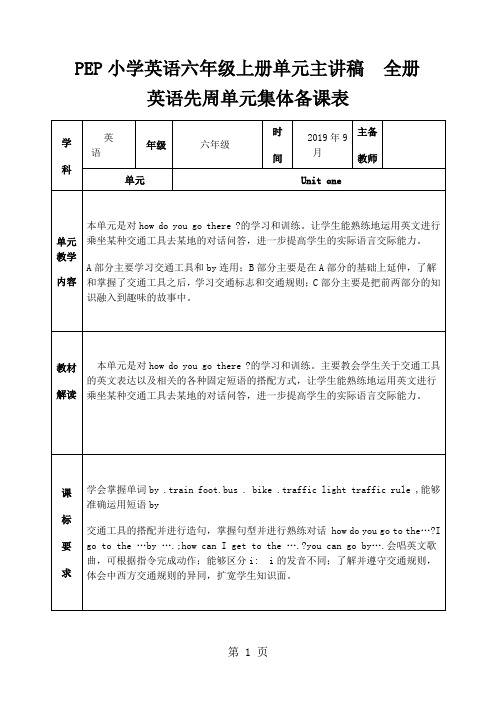
PEP小学英语六年级上册单元主讲稿全册英语先周单元集体备课表学科英语年级六年级时间2019年9月主备教师单元Unit one单元教学内容本单元是对how do you go there ?的学习和训练。
让学生能熟练地运用英文进行乘坐某种交通工具去某地的对话问答,进一步提高学生的实际语言交际能力。
A部分主要学习交通工具和by连用;B部分主要是在A部分的基础上延伸,了解和掌握了交通工具之后,学习交通标志和交通规则;C部分主要是把前两部分的知识融入到趣味的故事中。
教材解读本单元是对how do you go there ?的学习和训练。
主要教会学生关于交通工具的英文表达以及相关的各种固定短语的搭配方式,让学生能熟练地运用英文进行乘坐某种交通工具去某地的对话问答,进一步提高学生的实际语言交际能力。
课标要求学会掌握单词by .train foot.bus . bike .traffic light traffic rule ,能够准确运用短语by交通工具的搭配并进行造句,掌握句型并进行熟练对话 how do you go to the…?I go to the …by ….;how can I get to the ….?you can go by….会唱英文歌曲,可根据指令完成动作;能够区分i: i的发音不同;了解并遵守交通规则,体会中西方交通规则的异同,扩宽学生知识面。
教学目标学会掌握单词by .train foot.bus . bike .traffic light traffic rule ,能够准确运用短语by交通工具的搭配并进行造句,掌握句型并进行熟练对话 how do you go to the…?I go to the …by ….;how can I get to the ….?you can go by….教学重难点1.四会单词句子的书写。
2.主句型的熟练运用。
3.let’s read 的阅读。
人教PEP版六年级英语上册《Unit6_A_Let’s_talk优质说课稿》

人教PEP版六年级英语上册《Unit6_A_Let’s_talk优质说课稿》一. 教材分析《人教PEP版六年级英语上册Unit6 A Let’s talk》主要讲述了关于动物的特点。
本节课的主要内容是让学生能够听懂、会说、会读关于动物的句子,并能够运用所学知识进行简单的交流。
通过学习本节课,学生能够进一步巩固一般现在时态的运用,并且能够运用所学知识进行动物特点的描述。
二. 学情分析六年级的学生已经具备了一定的英语基础,对于一般现在时态的运用已经有了一定的了解。
但是,学生在动物特点的表达方面还存在一定的困难,因此,在教学过程中,需要重点引导学生运用英语表达动物的特点。
三. 说教学目标1.知识目标:学生能够听懂、会说、会读关于动物的句子,并能够运用所学知识进行简单的交流。
2.能力目标:学生能够运用一般现在时态描述动物的特点。
3.情感目标:学生能够对英语学习保持浓厚的兴趣,增强学习的自信心。
四. 说教学重难点1.重点:学生能够听懂、会说、会读关于动物的句子,并能够运用所学知识进行简单的交流。
2.难点:学生能够运用一般现在时态描述动物的特点。
五. 说教学方法与手段在本节课的教学过程中,我将采用任务型教学法,通过设置各种任务,引导学生主动参与学习,提高学生的学习兴趣和学习积极性。
同时,我会运用多媒体教学手段,如图片、视频等,帮助学生更好地理解和记忆动物的特点。
六. 说教学过程1.热身(5分钟):通过播放一首关于动物的歌曲,让学生复习已学的动物词汇,并引入本节课的主题。
2.呈现(10分钟):通过展示各种动物的图片,引导学生说出动物的名称,然后呈现本节课的主要句型,让学生听懂并能够模仿说出口。
3.操练(10分钟):通过各种游戏和活动,让学生充分练习本节课的主要句型,如“What does he/she look like? He/She looks like…”等。
4.巩固(10分钟):通过小组活动,让学生运用所学知识进行动物特点的描述,如“My animal looks like a… It has…”等。
六年级上册英语说课稿《UnitFourIHaveaPenPalBLet’stalk》人教(PEP)
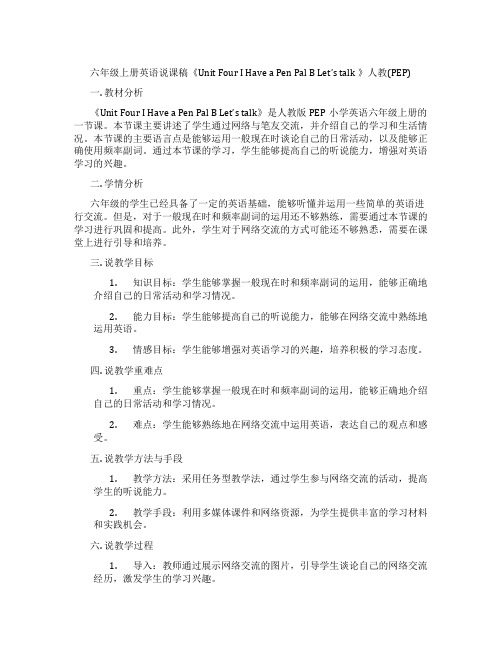
六年级上册英语说课稿《Unit Four I Have a Pen Pal B Let’s talk 》人教(PEP)一. 教材分析《Unit Four I Have a Pen Pal B Let’s talk》是人教版PEP小学英语六年级上册的一节课。
本节课主要讲述了学生通过网络与笔友交流,并介绍自己的学习和生活情况。
本节课的主要语言点是能够运用一般现在时谈论自己的日常活动,以及能够正确使用频率副词。
通过本节课的学习,学生能够提高自己的听说能力,增强对英语学习的兴趣。
二. 学情分析六年级的学生已经具备了一定的英语基础,能够听懂并运用一些简单的英语进行交流。
但是,对于一般现在时和频率副词的运用还不够熟练,需要通过本节课的学习进行巩固和提高。
此外,学生对于网络交流的方式可能还不够熟悉,需要在课堂上进行引导和培养。
三. 说教学目标1.知识目标:学生能够掌握一般现在时和频率副词的运用,能够正确地介绍自己的日常活动和学习情况。
2.能力目标:学生能够提高自己的听说能力,能够在网络交流中熟练地运用英语。
3.情感目标:学生能够增强对英语学习的兴趣,培养积极的学习态度。
四. 说教学重难点1.重点:学生能够掌握一般现在时和频率副词的运用,能够正确地介绍自己的日常活动和学习情况。
2.难点:学生能够熟练地在网络交流中运用英语,表达自己的观点和感受。
五. 说教学方法与手段1.教学方法:采用任务型教学法,通过学生参与网络交流的活动,提高学生的听说能力。
2.教学手段:利用多媒体课件和网络资源,为学生提供丰富的学习材料和实践机会。
六. 说教学过程1.导入:教师通过展示网络交流的图片,引导学生谈论自己的网络交流经历,激发学生的学习兴趣。
2.新课展示:教师通过多媒体课件展示本节课的主要内容,引导学生学习一般现在时和频率副词的运用。
3.课堂活动:学生分成小组,进行网络交流的角色扮演,练习一般现在时和频率副词的运用。
4.巩固练习:教师设计一些练习题,让学生进行听力理解和口语表达的练习。
人教PEP六年级上册英语教学说课稿《Unit1PartA》第一课时说课稿
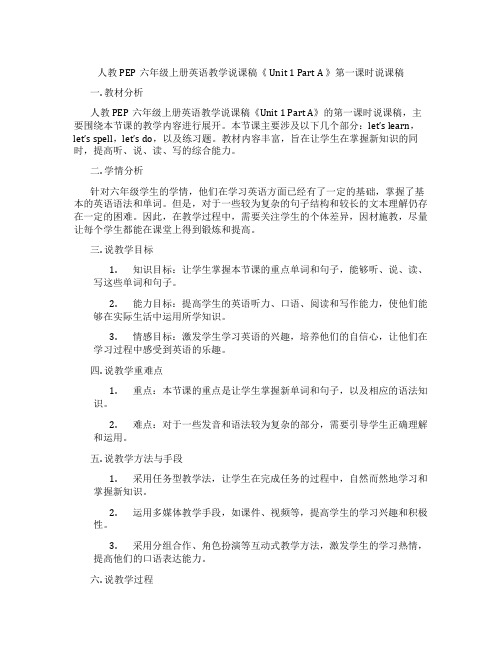
人教PEP六年级上册英语教学说课稿《 Unit 1 Part A 》第一课时说课稿一. 教材分析人教PEP六年级上册英语教学说课稿《Unit 1 Part A》的第一课时说课稿,主要围绕本节课的教学内容进行展开。
本节课主要涉及以下几个部分:let’s learn,let’s spell,let’s do,以及练习题。
教材内容丰富,旨在让学生在掌握新知识的同时,提高听、说、读、写的综合能力。
二. 学情分析针对六年级学生的学情,他们在学习英语方面已经有了一定的基础,掌握了基本的英语语法和单词。
但是,对于一些较为复杂的句子结构和较长的文本理解仍存在一定的困难。
因此,在教学过程中,需要关注学生的个体差异,因材施教,尽量让每个学生都能在课堂上得到锻炼和提高。
三. 说教学目标1.知识目标:让学生掌握本节课的重点单词和句子,能够听、说、读、写这些单词和句子。
2.能力目标:提高学生的英语听力、口语、阅读和写作能力,使他们能够在实际生活中运用所学知识。
3.情感目标:激发学生学习英语的兴趣,培养他们的自信心,让他们在学习过程中感受到英语的乐趣。
四. 说教学重难点1.重点:本节课的重点是让学生掌握新单词和句子,以及相应的语法知识。
2.难点:对于一些发音和语法较为复杂的部分,需要引导学生正确理解和运用。
五. 说教学方法与手段1.采用任务型教学法,让学生在完成任务的过程中,自然而然地学习和掌握新知识。
2.运用多媒体教学手段,如课件、视频等,提高学生的学习兴趣和积极性。
3.采用分组合作、角色扮演等互动式教学方法,激发学生的学习热情,提高他们的口语表达能力。
六. 说教学过程1.热身(5分钟):通过简单的英语歌曲或游戏,让学生放松心情,进入学习状态。
2.引入(10分钟):利用课件或视频展示本节课的主题,引导学生进入学习情境。
3.讲解(20分钟):讲解本节课的重点单词和句子,让学生听、说、读、写并进行实际操作。
4.练习(10分钟):布置一些针对性的练习题,让学生巩固所学知识。
人教PEP版六年级英语上册《Unit6_B_Let’s_talk优质说课稿》

人教PEP版六年级英语上册《Unit6_B_Let’s_talk优质说课稿》一. 教材分析人教PEP版六年级英语上册《Unit6 B Let’s talk》主要讲述了有关动物的知识。
本节课的主要内容是学习动物的名称以及它们的特点。
通过本节课的学习,学生能够听懂、会说、会读关于动物的词汇,如panda, tiger, cat, dog等,并能够运用所学生动物词汇进行简单的交流。
二. 学情分析六年级的学生已经具备了一定的英语基础,对于图片和简单句子能够进行理解和表达。
但是,学生在发音和听力方面还存在一些问题,需要通过本节课的教学进一步提高。
此外,学生对动物的认知程度不同,需要在教学中关注学生的个体差异,引导他们积极参与课堂活动。
三. 说教学目标1.知识目标:学生能够听懂、会说、会读关于动物的词汇,如panda,tiger, cat, dog等,并能够运用所学生动物词汇进行简单的交流。
2.能力目标:通过本节课的学习,学生的发音、听力、口语表达能力得到提高。
3.情感目标:培养学生热爱动物,关注生态环境的意识。
四. 说教学重难点1.重点:学生能够听懂、会说、会读关于动物的词汇,如panda, tiger,cat, dog等,并能够运用所学生动物词汇进行简单的交流。
2.难点:学生能够正确发音,并在实际情景中运用所学生动物词汇进行交流。
五. 说教学方法与手段本节课采用情境教学法、任务型教学法和分组合作法进行教学。
通过图片、视频、卡片等直观教具,激发学生的学习兴趣,提高他们的参与度。
同时,利用多媒体教学手段,如PPT、录音机等,为学生提供丰富的学习资源,帮助他们更好地掌握知识。
六. 说教学过程1.热身(5分钟)教师与学生进行简单的英语对话,检查学生的英语水平。
然后,引导学生谈论他们喜欢的动物,引出本节课的主题。
2.Presentation(10分钟)教师展示有关动物的图片,如panda, tiger, cat, dog等,引导学生说出动物的名称。
PEP小学英语六年级上册(全英)教案讲课讲稿
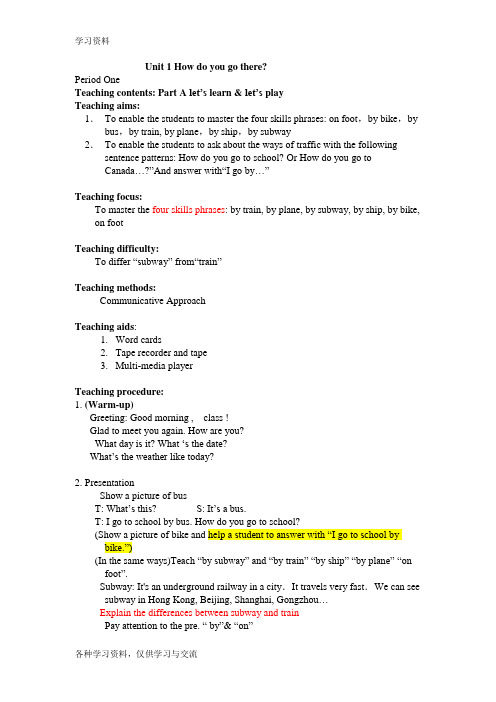
Unit 1 How do you go there?Period OneTeaching contents: Part A let’s learn & let’s playTeaching aims:1.To enable the students to master the four skills phrases: on foot,by bike,by bus,by train, by plane,by ship,by subway2.To enable the students to ask about the ways of traffic with the following sentence patterns: How do you go to school? Or How do you go toCanada…?”And answer with“I go by…”Teaching focus:To master the four skills phrases: by train, by plane, by subway, by ship, by bike, on footTeaching difficulty:To differ “subway” from“train”Teaching methods:Communicative ApproachTeaching aids:1.Word cards2.Tape recorder and tape3.Multi-media playerTeaching procedure:1. (Warm-up)Greeting: Good morning , class !Glad to meet you again. How are you?What day is it? What ‘s the date?What’s the weather like today?2. PresentationShow a picture of busT: What’s this? S: It’s a bus.T: I go to school by bus. How do you go to school?(Show a picture of bike and help a student to answer with “I go to school bybike.”)(In the same ways)Teach “by subway” and “by train” “by ship” “by plane” “onfoot”.Subway: It's an underground railway in a city.It travels very fast.We can see subway in Hong Kong, Beijing, Shanghai, G ongzhou…Explain the differences between subway and trainPay attention to the pre. “ by”& “on”3.Play gamesAsk one S to the front and stick the word cards next to the phrases written on the Bb when T read the new phrases quickly and the other Ss put up their cards. The one who reflect fastest and correctly is the winner.4.Listen to the tape of Part A Let’s learn and follow it.Pay attention to the tone and pronunciation5.Practice: Let’s playT Offer many places (the USA. England Australia Hong Kong ShanghaiGuangzhou the moon…) and traffic ways (by car/ taxi/ bus… on foot)Ss practice with above places and ways in pairs:A: How do you go to school?B: I go to school on foot.Encourage the Ss to make up as many sentences as they can.6.Spelling competitionDivide the class into tow groups. Show the pictures of traffic tools and ask Ss to spell the phrases. The first one who puts up hand gets the chance to spell. The group spell out more phrases are the winners.HomeworkCopy the new words and phrasesFinish Page1 of the ABBb design:Unit One How do you go there?How do you go to school/ Canada?I go to school on foot/ by subway/ bus/ train/ taxi…Teaching reflection:Unit1 How do you go there?Period TwoTeaching contents: Let’s t ry & let’s talkTeaching aims:1.To master the four skills sentence: “How do you go to school? Usually I go toschool on foot.Sometimes I go by bike.”2.To enable the Ss to ask and answer about traffic ways and explain the simplereason why he or she chose this traffic way.I go to school on foot, because my home is near.3.To make the Ss understand the listening material in “Let’s try”情感目的Teaching focus:文中的新句子To use and write the following key sentences:How do you go to school?Usually I go to school by bike. Sometimes I go on foot.Teaching difficult points:To write the key sentences: How do you go to school?Usually I go to school on foot.Sometimes I go by bike.To use Adverbs of frequency: usually, sometimesTeaching aids:Tape recorder Teaching cards a piece of paperTeaching procedure:1. (Warm-up)T: Good morning! How do you go to school today? What about you? Do you go by bus,too?”2. Have a dictationAsk the Ss to dictate the new words learnt in the last lesson.On foot、by bus、by train、by plane、by subway…3. Let'stryGuide the Ss to look at the pictures and askWho’s the boy? He’s Mike. How does Mike go to school?Play the tape and listen:John:How do you go to school,Mike?Mike:I usually go to school by bike.Sometimes I go 0n foot.John:Is your home near our school?Mike:Yes.it is.J0hn:That's fine!4. (Presentation)Let's talkT: How do I go to school,do you know? Ask me,please!Draw a bike, a bus, a taxi on the Bb and write the price by each picture. Bus 1 yuan taxi 10 yuanEncourage the Ss to ask “How do you go to school?T: Usually I go to school by bike, because it's good exercise.Sometimes I go by bus,because it's cheap.It costs l yuan. Sometimes I go by taxi,because it'sfast,but it's too expensive.It costs 1o yuan.Explain that we use usually and sometimes to express frequency.T: “How does Sarah go to school? Listen.”Ask the S to imitate Sarah’s tone to answerSarah: Usually I to go school on foot. Sometimes I go bike.Ss read after the tape. Then practice in pairs to make up the new dialogueaccording to each picture.Ask several pairs to act out the dialogue.5. Group workRead the dialogue .Then practice in groups of four. They can expand theirdialogue like the following:A:How do you go to school/ hometown?B:Usually I go by bus.A:Can you go by bike?B: Yes,I can,but it's too far.Sometimes I go by taxi,because it’s fast, but it's expensive. What about you?A:I go to school on foot,because my home is near.6. Play finding order gamesShow the following word cards and ask Ss to form correct sentences.How, do, go, to, school, youI, usually, on, go, school, to, footSometimes, by, bike, go, IHomework:Finish AB Page2Bb designUnit1 How do you go thereHow do you go to school?Usually I go to school on foot, because it’s near.Sometimes I go by bike, because it’s fast.Period ThreeTeaching contents: Let’s readTeaching aims:1.To improve reading skill2.To consolidate the traffic ways3.To improve understanding ability.Teaching focus:How do we go to the park?It’s easy.How to finish answering the questions in the bookTeaching difficult points:How to express the different ways to a placeTeaching aids:Tape recorder a piece of paper masks of Zhang Peng and Sarah Teaching procedure:1.ReviewFree talk2.Dictation 复习上节课学过的句子和词语How do you go to school?Usually I go to school on foot.Sometimes I go by bike. What about you?3.Review different placesT: This is a very nice place. There are many students and teachers. There are many rooms, such as classroom, art room, music room… What’s it?It’s a beautiful place. Many people like to play in it. There are nice flowers, trees and grass. There are toys. What is it?It’s a park.4.PresentationT: Where is my home? Do you want to know?Describe with different traffic ways and use “first” “next” “then” .It’s a little far from here. First I go to Zenbu bus stop on foot. Then I can go bythe No.74 bus to the East Bus Station... We live on the ninth floor,Room902.Explain “then”5.T ask individual :Where is your home?Is it near the park? Which floor?In pairs practice above questions6.Play the tape and students follow it.Ask: How can we go to Sarah’s home?How can they go to the park?Finish answering the questions, and then check the answers.7.PracticeRead the text. Boys to be Zhang Peng ,and girls to be Sarah. 男女分组朗读Work in pairs to read the dialogue.Ask several pairs to act out.8.Make up new dialoguesHomework:Do Page 5 in ABMake a survey and fill in the following formBb design:How do we go to the park?It’s easy.Which floor?The fifth floor, Room 5APeriod FourTeaching contents: Let’s learn and let’s playTeaching aims:1. To master the phrases: Stop at a red light. Wait at a yellow light. Go at a greenlight.2. To know some traffic rules about traffic lightsTeaching focus:To understand the traffic lights commands and do the action:Stop at a red light.Wait at a yellow light.Go at a green light.Teaching difficult points:To understand the meaning of the three traffic lights and do the correct actionof the commandsTeaching aids:Tape recorderA flash card of traffic lightsWord cardsTeaching procedure:1.Free talk2.ReviewHow do you go …?Ss should make a true answer and give the reason.3.Warm-upAsk Ss to do actions when they hear the orderStand up, touch your ears,Turn Left, right, go, turn around…4.Revise the words of colours5.T: ( show traffic lights)What are they?They are traffic lights.T: How many colour?What colours are they?What do they mean?T Show a red light and say:It’s a red light. I must stop at a red light.It’s a yellow light. I must wait at a yellow light.It’s a green light. I can go at a green light.Do you know the traffic rules?Draw three traffic lights on the Bb and write the traffic rules next to themStop at a red light.Wait at a yellow light.Go at a green light.6.Play the tape and Ss follow it.Explain “remember” by doing gesture.7.Let’s playAsk ten students to the front to do actions of traffic lights commandsFive girls are Group A. The other boys are Group B. When T show the yellow light they must wait. If not the one who disobeysShould get back to the seat. In the end the group with more people win the game.8. Consolidation and extension巩固和拓展(难点)Discuss the different traffic ways and rulesHow do you go to school?I go to school On foot.Can you tell me any traffic rules?You must watch the traffic 1ights.I go to school by bus.Can you tell me any traffic rules?Don't run in the bus.Don't stick your head Or arms out Of the window.I go to school by bike.Can you tell me any traffic rules?Don't go too fast.Never go into the sideways.Homework:Copy the traffic rules written on the BbFinish AB Page4Bb design:Traffic lights traffic rulesRed light Stop at a red light.Yellow light Wait at a yellow lightGreen light Go at a green light.Teaching reflection:Period 5Teaching contents: Let’s readTeaching aims:1.To improve reading skill2.To consolidate the traffic rules and know different countries have differenttraffic rules.3.To improve understanding ability and make Ss get right information from thereading material.Teaching focus:Understanding the the meaning of the text and finishing the “tick or cross”Teaching difficult points:To improve the reading skillsTo understanding the following sentences:In China/the US,drivers drive on the right side Of the road.In England and Australia,however,drivers drive On the 1eft side Of the road.Teaching aids:Tape recorder flash card of traffic lightsA photo of Singapore StreetTeaching procedure:1.Free talk2.ReviewStop at a red light.Wait at a yellow light.Go at a green light.Let the Ss do the actionsDictate the above sentences.3.T: (put up the right hand) This is my right hand. Show me your right hand! Thenshow me your left hand.Do actions as I tell you:Turn left. Turn right. Turn back. Touch your left ear…4.Discuss traffic rulesT: Red means “stop” .if the light is red, you must stop.Yellow means________ ,if the light is yellow you must ______.Green means _________, if the light is green you can ________.5.Show a photo of Singapore Street and ask the Ss to find out the differences.T: The traffic lights are the same in every country. But what about other traffic rules? Look at the picture. It’s in Singapore. what‘s the differences.Help the Ss to answer:In Singapore, the driver is on the left side. In China the driver is on the right side.6.ReadAsk the Ss to read the passage and do the exercises.Check the answer together.Teach new words:Find difference every countryAlways drive if mustKnow England Australia howeverExplain the following sentences:In China, drivers drive on the right side of the road.In England and Australia, however, drivers drive on the left side of the road.Read the text again and put up any questions.HomeworkAsk Ss to find more traffic rulesBb designThe same every country alwaysMean drive right side England AustraliaHowever if must knowTeaching reflectionPeriod Seven●Teaching contents: Good to know, let’s sing,●Teaching aims:1.To recognize some usual traffic signs.2.To improve the student’s traffic consciousness3.To understand and sing the song “How do you go to school?●Teaching focus:Ss can say these traffic rules according to the traffic sings:Crosswalk No entry、Turn right、NO bikes、One way、No left turn●Teaching difficult points :To recognize the traffic signs●Teaching methods: Read and perform●Teaching aids:Tape recorder Powerpoints●Teaching procedure:Step 1.Review1.Duty report: Good morning, everyone. I’m on duty today. Today is Monday,September 19th.It is sunny today .Everyone is here .Thank you!Step 2.DictationDictate the new words we have learned last week.Step 3.Review the traffic rules1Ask some students: “How do you go to school? Why?”Get Ss to talk freely.2.Review the traffic rules.Show the traffic lights, ask “What are these? What colors are they? What does it mean?”Get Ss to answer.3.T: The traffic lights are the same in every country, but the traffic rules aredifferent.For example: In China, drivers drive on the right side of the road? What about in England and Australia? Get Ss to answer: Drivers drive on the left side of the road.Step4. Presentation1. T: If you go by car, by bike or on foot, you must know some traffic rules.What other rules do you know?Encourage Ss to say some traffic rules.2. Show some traffic signsT: Where can you see there pictures? (In the street. /On the road.)Do you know what they mean?Show the pictures one by one and tell them the traffic rules:Crosswalk: If you cross the road, you must walk on the crosswalk.Turn right : You can turn right if you see this picture .Turn left : You can turn left if you see this picture.One way : In one directionNo entry :Don’t come in .No bike : Don’t ride a bike .No left turn : Don’t turn left .No right turn: Don’t turn right .Step 5 .PracticeGet Ss to match the signs with the words.Ss can make some other traffic signs by themselves.Step 6.Sing a songPlay the tape, Ss listen and try to sing the song “How do you go to sch ool?”Homework:Finish Exercise 5 on page3 of the activity book.Make a survey .Ask the classmates: How do you go to school ?And complete the form on page 10.Bb design:Crosswalk No entry Turn right Turn leftNo bikes One way No left turn No right turnTeaching reflection:The tenth lesson●Teaching contents : Pronunciation, Let’s check●Teaching aims :1.To recognize and read the phonetic symbol /i: / / i/ /p / /b / /t / /d /2.To read the syllable that these phonetic symbol make up.3.Ss listen to the passage in let’s check and tick.●Teaching focus :Recognize the phonetic symbols.●Teaching difficulty :Ss can read the syllables include the phonetic symbols have in this lesson●Teaching methods :Read and listen●Teaching aids :Tape recorder and tapeSome cards of phonetic symbolsMulti-media playerSome word cards.●Teaching procedure:1 Review.Duty report.Ask the Ss freely: How do you go to school ?2 The phonetic teaching and practice(1) Write two houses on the Bb, one is high, the other is low.The teacher points to the first house, say: This is Miss Eagle’s house .How do you go to Miss Eagle’s house? We can go by plane.Show a word card with peak and say: Hello,I’m Peak .I’m in Miss Eagle’s house .Then put this word in the house .Then show other words cards, and get students put them in the right places.Then get students to read these words and the phonetic symbols/p / /b / /t / /d / /i: /Tell the Ss, in a word, the letters ee and ea usually sound /i: /(2) Then show the house of Mr Pig and use the same way to teach / i/(3) Play the tape, get students read the phonetic symbols and words after the tape.(4) Match the phonetic symbols with the right words.(5) Read some wordsbe bean beef bee dean deed teach pea tea eatbid bit did dig dip pick till tick tip pink(6) Read some tongue –twisters1. This is a big pink pig, a big pink pig .Is it a big pink pig? Yes, it is, Yes, it is.2. P .P. P, can we eat some peas? Please, please, please, eat some peas!3. Teacher, teacher, teacher. Can we eat the pizza? No, no, no, please eat green beans!3. ListeningPlay the tape, get students to listen and do the exercise.① John: How do you go to school, Amy?Amy: I usually go to school on foot .My home is not far from school.② John: How can I get to the post office, please?Zhang: You can go by bike .It just in front of our school.③Liu: Where is the zoo, please?Mike: It’s near my home.You can go by the No.4 bus.Liu: Can I go by subway?Mike: Sure, If you like.④ Chen: Is the park far from here?Amy: Yes, it is .You can go by the No.5 bus.Chen: Can I go by bike?Amy: No, that’s too far.Homework:1.Read the tongue-twisters after class.2.Finish the exercises on page 7 of the activity book.Teaching reflection:The eleventh lesson●Teaching contents: Review the words and sentences in Unit one.●Teaching aims:1.Review the words in this unit: by foot bike bus train plane shipsubway how go to school traffic traffic light traffic rule stop wait get to2.The main sentences :How do you go to school ? I go to school …How can I get to …? You can go by No. bus .3. Review the traffic rules .a. Stop at a red light .b. Wait at a yellow light .c. Go at a green light .d. Drivers drive on the right side of the road in China.Drives drive on the left side of the road in England ,Australia and HongKong.4. Review the phonetic symbols /i: / / i/ /p / /b / /t / /d /●Teaching focus:Ss can master the words and sentences .●Teaching difficulty:Ss can use the words and sentences to make a dialogue .●Teaching methods:Read and practice●Teaching procedure:1. T: Today we will review what we learned in this unit .Show the powerpoints of Let’s learn and ask How do you go to school ?Get Ss to answer :I go to school by bike /by car /by bus /on foot.Write the sentences and words on the Bb .The twelfth lesson●Teaching contents:Do some exercises.●Teaching aims:To review the words and sentences in Unit One .●Teaching focus:To practice the words and sentences they have learned .●Teaching methods:Students do the exercises by themselves .●Teaching aids:Multi-media player●Teaching procedure:Do the exercises1.Read and fill in the blanks .阅读,填空1._______ do you go to Hainan? I go by ship .2.I usually go to visit my grandma ___ foot .________ (有时) I go ___ bike .3 I am a student ,____ ____ you ? I’m a stu dent too .4.---Let’s go to the park this afternoon .--- Ok ,see you ____ 3 o’clock .--- _______ _______ then .2.Read and choose .选择填空( ) 1. Go _____ a green light . A. to B. at C. in( ) 2. The ______ are the same in every country .A.traffic lightsB.traffic rules C . traffic( ) 3. In the Us, drivers drive ______ the right side.A. in B . on C. to3.( ) 4 . Look at the lights .Yellow ______ “ wait”.A. means B meaning C . mean( ) 5. Now I am standing on the left side ____ the road .A. inB. onC. of( ) 6. ______ can you get to the zoo ? By bus.A. How B . What C. Where3. Read and write .朗读,填空1. Look at me ! I _______ (经常) go to school _____ _____.2. Please remember the _____ _____ (交通规则). ______ at a green light .3. I go school _____ bike .But _____(有时) I go ______ taxi.4. _____ at a red light .5.Look at the ______ ______ (交通灯)。
PEP小学英语公开课六年级上册Unit1第一课时说课稿
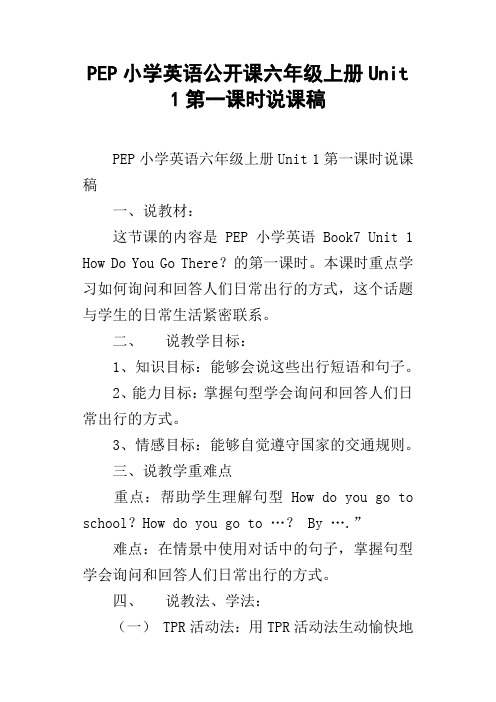
PEP小学英语公开课六年级上册Unit1第一课时说课稿PEP小学英语六年级上册Unit 1第一课时说课稿一、说教材:这节课的内容是PEP小学英语Book7 Unit 1 How Do You Go There?的第一课时。
本课时重点学习如何询问和回答人们日常出行的方式,这个话题与学生的日常生活紧密联系。
二、说教学目标:1、知识目标:能够会说这些出行短语和句子。
2、能力目标:掌握句型学会询问和回答人们日常出行的方式。
3、情感目标:能够自觉遵守国家的交通规则。
三、说教学重难点重点:帮助学生理解句型How do you go to school?How do you go to …? By ….”难点:在情景中使用对话中的句子,掌握句型学会询问和回答人们日常出行的方式。
四、说教法、学法:(一) TPR活动法:用TPR活动法生动愉快地让学生适应上课,开始进入状态,同时是一个对以前的学习内容的复习,为下面的学习内容做铺垫,为学生展开新内容提供知识基础,也为课堂气氛增色不少。
(二)词不离句(语境):每一个陌生的单词或词组,都放在句子中让学生去理解,培养学生在语境中猜词的能力。
(三)小组学习法:每四个人一组,在互动中互相启发产生思维的碰撞,同时注意保证每个学生都有机会参与学习、而培养学生和伙伴合作的意识和策略,提高人际交往能力。
学生也在独立与合作的交织中调控了自身的学习,变得自信、自强。
(四)训练法:让学生充分的弄懂和运用单词和词组。
(五)借助实物教学法来呈现材料,激发学生的学习兴趣和求知欲。
PEP小学英语六年级上册Unit 1第一课时说课稿一、说教材:这节课的内容是PEP小学英语Book7 Unit 1How Do You Go There?的第一课时。
本课时重点学习如何询问和回答人们日常出行的方式,这个话题与学生的日常生活紧密联系。
二、说教学目标:1、知识目标:能够会说这些出行短语和句子。
2、能力目标:掌握句型学会询问和回答人们日常出行的方式。
六年级上册英语说课稿《Unit4IhaveapenpalPeriod6》人教PEP版说课稿
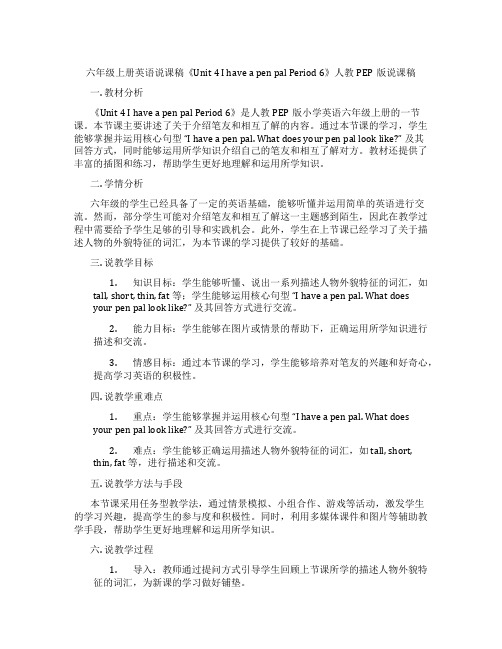
六年级上册英语说课稿《Unit 4 I have a pen pal Period 6》人教PEP版说课稿一. 教材分析《Unit 4 I have a pen pal Period 6》是人教PEP版小学英语六年级上册的一节课。
本节课主要讲述了关于介绍笔友和相互了解的内容。
通过本节课的学习,学生能够掌握并运用核心句型“I have a pen pal. What does your pen pal look like?” 及其回答方式,同时能够运用所学知识介绍自己的笔友和相互了解对方。
教材还提供了丰富的插图和练习,帮助学生更好地理解和运用所学知识。
二. 学情分析六年级的学生已经具备了一定的英语基础,能够听懂并运用简单的英语进行交流。
然而,部分学生可能对介绍笔友和相互了解这一主题感到陌生,因此在教学过程中需要给予学生足够的引导和实践机会。
此外,学生在上节课已经学习了关于描述人物的外貌特征的词汇,为本节课的学习提供了较好的基础。
三. 说教学目标1.知识目标:学生能够听懂、说出一系列描述人物外貌特征的词汇,如tall, short, thin, fat 等;学生能够运用核心句型“I have a pen pal. What doesyour pen pal look like?” 及其回答方式进行交流。
2.能力目标:学生能够在图片或情景的帮助下,正确运用所学知识进行描述和交流。
3.情感目标:通过本节课的学习,学生能够培养对笔友的兴趣和好奇心,提高学习英语的积极性。
四. 说教学重难点1.重点:学生能够掌握并运用核心句型“I have a pen pal. What doesyour pen pal look like?” 及其回答方式进行交流。
2.难点:学生能够正确运用描述人物外貌特征的词汇,如 tall, short,thin, fat 等,进行描述和交流。
五. 说教学方法与手段本节课采用任务型教学法,通过情景模拟、小组合作、游戏等活动,激发学生的学习兴趣,提高学生的参与度和积极性。
PEP小学英语六年级上册单元主讲稿 全册
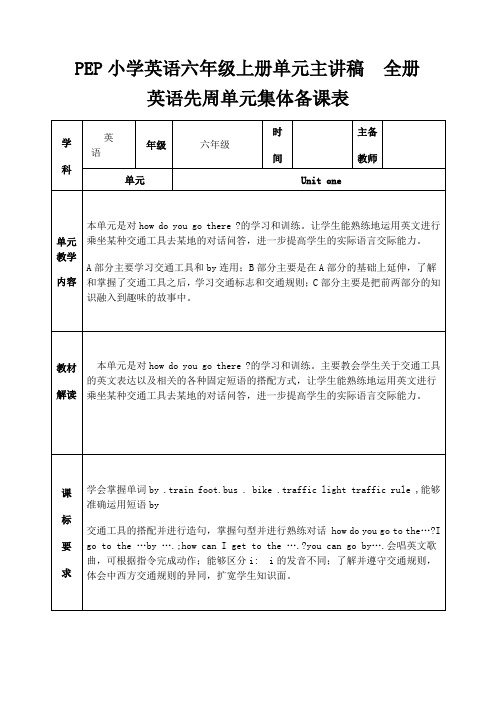
PEP小学英语六年级上册单元主讲稿全册英语先周单元集体备课表学科英语年级六年级时间主备教师单元Unit one单元教学内容本单元是对how do you go there ?的学习和训练。
让学生能熟练地运用英文进行乘坐某种交通工具去某地的对话问答,进一步提高学生的实际语言交际能力。
A部分主要学习交通工具和by连用;B部分主要是在A部分的基础上延伸,了解和掌握了交通工具之后,学习交通标志和交通规则;C部分主要是把前两部分的知识融入到趣味的故事中。
教材解读本单元是对how do you go there ?的学习和训练。
主要教会学生关于交通工具的英文表达以及相关的各种固定短语的搭配方式,让学生能熟练地运用英文进行乘坐某种交通工具去某地的对话问答,进一步提高学生的实际语言交际能力。
课标要求学会掌握单词by .train foot.bus . bike .traffic light traffic rule ,能够准确运用短语by交通工具的搭配并进行造句,掌握句型并进行熟练对话 how do you go to the…?I go to the …by ….;how can I get to the ….?you can go by….会唱英文歌曲,可根据指令完成动作;能够区分i: i的发音不同;了解并遵守交通规则,体会中西方交通规则的异同,扩宽学生知识面。
教学目标学会掌握单词by .train foot.bus . bike .traffic light traffic rule ,能够准确运用短语by交通工具的搭配并进行造句,掌握句型并进行熟练对话 how do you go to the…?I go to the …by ….;how can I get to the ….?you can go by….教学重难点1.四会单词句子的书写。
2.主句型的熟练运用。
3.let’s read 的阅读。
4.选择合适的交通工具并进行原因分析。
人教PEP六年级上册英语教学说课稿《Unit6PartB》第三课时说课稿
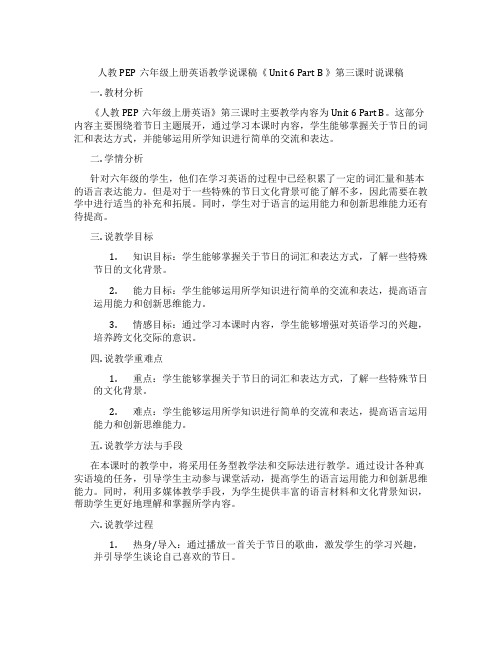
人教PEP六年级上册英语教学说课稿《 Unit 6 Part B 》第三课时说课稿一. 教材分析《人教PEP六年级上册英语》第三课时主要教学内容为Unit 6 Part B。
这部分内容主要围绕着节日主题展开,通过学习本课时内容,学生能够掌握关于节日的词汇和表达方式,并能够运用所学知识进行简单的交流和表达。
二. 学情分析针对六年级的学生,他们在学习英语的过程中已经积累了一定的词汇量和基本的语言表达能力。
但是对于一些特殊的节日文化背景可能了解不多,因此需要在教学中进行适当的补充和拓展。
同时,学生对于语言的运用能力和创新思维能力还有待提高。
三. 说教学目标1.知识目标:学生能够掌握关于节日的词汇和表达方式,了解一些特殊节日的文化背景。
2.能力目标:学生能够运用所学知识进行简单的交流和表达,提高语言运用能力和创新思维能力。
3.情感目标:通过学习本课时内容,学生能够增强对英语学习的兴趣,培养跨文化交际的意识。
四. 说教学重难点1.重点:学生能够掌握关于节日的词汇和表达方式,了解一些特殊节日的文化背景。
2.难点:学生能够运用所学知识进行简单的交流和表达,提高语言运用能力和创新思维能力。
五. 说教学方法与手段在本课时的教学中,将采用任务型教学法和交际法进行教学。
通过设计各种真实语境的任务,引导学生主动参与课堂活动,提高学生的语言运用能力和创新思维能力。
同时,利用多媒体教学手段,为学生提供丰富的语言材料和文化背景知识,帮助学生更好地理解和掌握所学内容。
六. 说教学过程1.热身/导入:通过播放一首关于节日的歌曲,激发学生的学习兴趣,并引导学生谈论自己喜欢的节日。
2.呈现/新课导入:教师通过展示一些特殊节日的图片,引导学生猜测和表达这些节日的名称,从而引入本课时的新内容。
3.操练/互动活动:教师设计各种任务和活动,让学生在真实语境中运用所学知识进行交流和表达,提高语言运用能力和创新思维能力。
4.巩固/拓展活动:教师提供一些有关特殊节日的文化背景知识,帮助学生更好地了解和理解这些节日的意义,并进行小组讨论和分享。
人教PEP版六年级上册英语全册优质说课稿
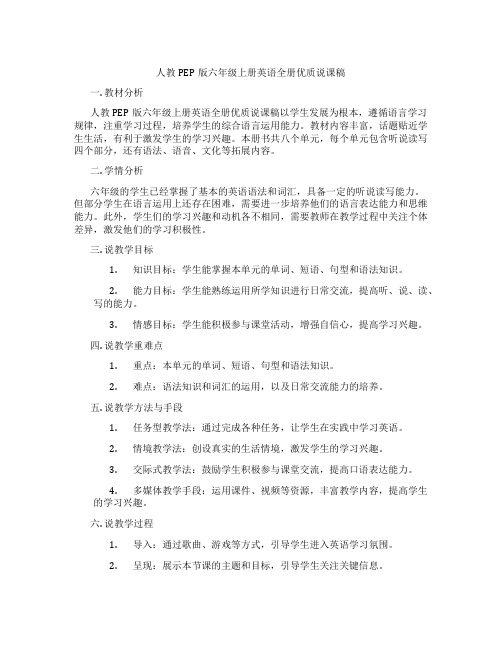
人教PEP版六年级上册英语全册优质说课稿一. 教材分析人教PEP版六年级上册英语全册优质说课稿以学生发展为根本,遵循语言学习规律,注重学习过程,培养学生的综合语言运用能力。
教材内容丰富,话题贴近学生生活,有利于激发学生的学习兴趣。
本册书共八个单元,每个单元包含听说读写四个部分,还有语法、语音、文化等拓展内容。
二. 学情分析六年级的学生已经掌握了基本的英语语法和词汇,具备一定的听说读写能力。
但部分学生在语言运用上还存在困难,需要进一步培养他们的语言表达能力和思维能力。
此外,学生们的学习兴趣和动机各不相同,需要教师在教学过程中关注个体差异,激发他们的学习积极性。
三. 说教学目标1.知识目标:学生能掌握本单元的单词、短语、句型和语法知识。
2.能力目标:学生能熟练运用所学知识进行日常交流,提高听、说、读、写的能力。
3.情感目标:学生能积极参与课堂活动,增强自信心,提高学习兴趣。
四. 说教学重难点1.重点:本单元的单词、短语、句型和语法知识。
2.难点:语法知识和词汇的运用,以及日常交流能力的培养。
五. 说教学方法与手段1.任务型教学法:通过完成各种任务,让学生在实践中学习英语。
2.情境教学法:创设真实的生活情境,激发学生的学习兴趣。
3.交际式教学法:鼓励学生积极参与课堂交流,提高口语表达能力。
4.多媒体教学手段:运用课件、视频等资源,丰富教学内容,提高学生的学习兴趣。
六. 说教学过程1.导入:通过歌曲、游戏等方式,引导学生进入英语学习氛围。
2.呈现:展示本节课的主题和目标,引导学生关注关键信息。
3.实践:让学生在真实情境中练习所学知识,如角色扮演、小组讨论等。
4.巩固:通过各种活动,让学生巩固所学知识,如听力练习、口语表达等。
5.拓展:引导学生运用所学知识进行创新性表达,如编写故事、表演节目等。
6.总结:对本节课的内容进行总结,强调重点知识点。
7.作业布置:布置适量作业,让学生巩固所学知识。
七. 说板书设计板书设计应简洁明了,突出本节课的重点知识点。
人教PEP六年级上册英语教学说课稿《 Unit 6 Part B 》第一课时说课稿

人教PEP六年级上册英语教学说课稿《 Unit 6 Part B 》第一课时说课稿一. 教材分析人教PEP六年级上册英语教学说课稿《Unit 6 Part B》第一课时说课稿,主要围绕本课时的重要内容进行讲解。
本课时主要涉及到一般现在时的肯定句和否定句的构成,以及一般现在时的疑问句。
通过学习本课时,学生能够掌握一般现在时的构成和用法,并能够运用到实际情景中。
二. 学情分析六年级的学生已经具备了一定的英语基础,对于一般现在时的概念和用法已经有了一定的了解。
但是,学生在运用一般现在时进行交流时,还存在一些问题,如疑问句的构成和否定句的使用。
因此,在教学过程中,需要重点讲解和练习疑问句的构成和否定句的使用。
三. 说教学目标1.知识目标:学生能够掌握一般现在时的肯定句、否定句和疑问句的构成和用法。
2.能力目标:学生能够运用一般现在时进行简单的交流和描述。
3.情感目标:激发学生学习英语的兴趣,培养学生的自信心。
四. 说教学重难点1.教学重点:一般现在时的肯定句、否定句和疑问句的构成和用法。
2.教学难点:疑问句的构成和否定句的使用。
五. 说教学方法与手段1.教学方法:采用任务型教学法,通过任务的设计和完成,引导学生自主学习、合作学习和探究学习。
2.教学手段:利用多媒体课件、图片、卡片等教学辅助工具,以及课堂游戏和活动,提高学生的学习兴趣和参与度。
六. 说教学过程1.热身(5分钟):通过歌曲或简单的口语练习,引导学生进入学习状态。
2.引入(10分钟):利用图片或情境,引导学生思考一般现在时的概念和用法。
3.讲解(15分钟):讲解一般现在时的肯定句、否定句和疑问句的构成和用法,并通过实例进行讲解和练习。
4.练习(10分钟):设计相关的练习题,让学生进行小组讨论和回答,巩固所学的知识。
5.任务(10分钟):设计一个小任务,让学生运用一般现在时进行交流和描述,培养学生的实际应用能力。
6.总结(5分钟):对本节课的内容进行总结,强调一般现在时的构成和用法。
pep六上英语公开课说课稿

pep六上英语公开课说课稿PEP六年级上册英语公开课的说课稿应该包括以下几个部分:课程介绍、教学目标、教学重点和难点、教学方法、教学过程、板书设计、作业布置以及教学反思。
课程介绍:本节课选自PEP小学英语六年级上册,Unit 3 "My Weekend Plan"。
通过本单元的学习,学生将能够使用一般将来时态来描述自己的周末计划,同时能够询问和回答有关周末活动的问题。
教学目标:1. 知识与技能:学生能够掌握一般将来时态的基本结构,并能够正确使用"will"和"be going to"来表达将来的计划。
2. 过程与方法:通过小组合作和角色扮演,学生能够提高语言实践能力,增强语言运用的灵活性。
3. 情感态度与价值观:培养学生合理安排时间,积极规划周末活动的习惯。
教学重点:- 一般将来时态的构成和用法。
- 使用"will"和"be going to"来表达将来的计划。
教学难点:- "will"和"be going to"的区分和正确使用。
教学方法:- 情景教学法:通过创设情景,让学生在实际语境中学习和使用语言。
- 任务型教学法:设计任务驱动学生学习,提高学生的语言实践能力。
- 合作学习法:通过小组合作,促进学生之间的交流和互助。
教学过程:1. 导入(Lead-in):通过展示周末活动的图片,激发学生对周末计划的兴趣。
2. 新课呈现(Presentation):介绍一般将来时态的结构,并通过例句展示"will"和"be going to"的用法。
3. 操练(Practice):通过填空、转换句型等练习,巩固学生对一般将来时态的掌握。
4. 应用(Application):小组合作,制定自己的周末计划,并在班级前进行展示。
5. 总结(Summary):回顾本节课的重点内容,强调一般将来时态的用法。
pep小学六年级英语说课稿

《P E P小学英语》六年级下册Unit 3 Last Weekeed一、教材分析:本课出自于《PEP小学英语》六年级下册Unit 3 Last Weekeed第一课时.这是一节运用所学知识表达在过去时间内所做事情的课时.二、学情分析:六年级的学生对于英语已经有了一定的自主学习能力.同时,学生已经掌握较多的动词短语,为本课时的学习打下了基础,本课时,学生将在已学动词短语的基础上,掌握一般动词过去式的构成以及部分不规则动词的过去式,同时,谈论过去时间内所干的事情.三、教学目标:1、认知目标:1)能够听,说,读,写短语watched TV,washed the clothes,cleaned the room,played football,visited grandparents.2)能听懂问句What did you do last weekend?并做出正确回答。
3)能运用所学语言知识完成Let's find out的任务。
2、能力目标:能够用一般过去时描述自己在过去时间里所做的事情。
3、情感目标:通过本课语言知识的学习,教育学生应多熟悉身边的人所做的事情,并能做到经常关心他人。
四、教学重、难点:1、本课时的教学重点是掌握Let’s learn部分动词短语的过去式以及就过去时间所做的事情进行简单回答。
2、本课时的教学难点之一是动词短语过去式的拼写,二是动词过去式的发音。
五、课前准备:教师准备本课时的动词短语卡片。
六、教学方法设计:教法:采用游戏教学法,任务型教学法,情景教学法和交际法.学法:听读法和合作学法.七、教学过程设计:环节一:热身训练, 提高兴趣; 环节二:复习旧知, 导入新课; 环节三:新知呈现, 突出重点;环节四:拓展延伸, 课后运用. 具体教学过程如下:1、? Warm-up热身(1)日常口语训练:Good morning! Glad to meet you. How are you(2)玩游戏,猜单词。
pep小学英语6年级说课稿
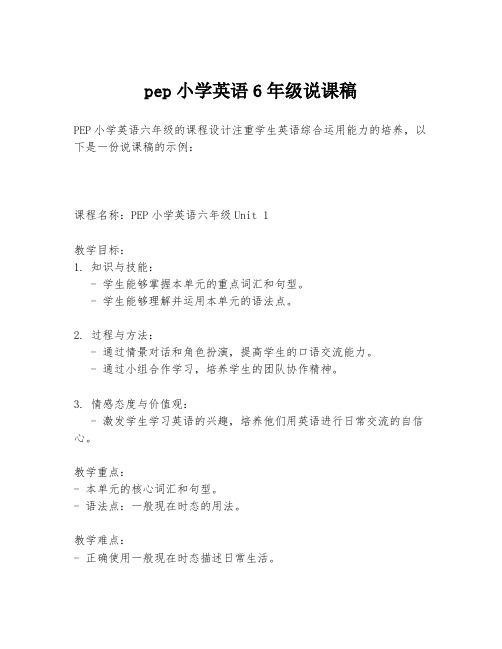
pep小学英语6年级说课稿PEP小学英语六年级的课程设计注重学生英语综合运用能力的培养,以下是一份说课稿的示例:课程名称:PEP小学英语六年级Unit 1教学目标:1. 知识与技能:- 学生能够掌握本单元的重点词汇和句型。
- 学生能够理解并运用本单元的语法点。
2. 过程与方法:- 通过情景对话和角色扮演,提高学生的口语交流能力。
- 通过小组合作学习,培养学生的团队协作精神。
3. 情感态度与价值观:- 激发学生学习英语的兴趣,培养他们用英语进行日常交流的自信心。
教学重点:- 本单元的核心词汇和句型。
- 语法点:一般现在时态的用法。
教学难点:- 正确使用一般现在时态描述日常生活。
教学方法:- 情景教学法- 任务型教学法- 小组合作学习教学准备:- 教学PPT- 相关图片和实物- 录音设备教学过程:1. 导入(Lead-in)- 通过播放与本单元主题相关的视频或歌曲,激发学生兴趣,引入新课。
2. 呈现(Presentation)- 利用图片和实物,呈现本单元的新词汇和句型,确保学生能够正确发音和理解。
3. 操练(Practice)- 通过角色扮演和情景对话,让学生在实际语境中运用新学的语言点。
4. 应用(Application)- 设计任务型活动,如填写表格、写日记等,让学生在实际应用中巩固所学知识。
5. 产出(Production)- 组织小组讨论或汇报,让学生展示他们的学习成果。
6. 小结(Summary)- 总结本节课的重点内容,强调语法点的运用。
7. 作业(Homework)- 布置与本单元主题相关的作业,如写一篇关于日常生活的小短文。
板书设计:- 单元标题- 核心词汇- 句型结构- 语法点提示教学反思:- 课后,教师应根据学生的反馈和表现,反思教学方法和内容,不断优化教学设计。
请注意,这只是一个说课稿的示例,具体内容应根据实际教学计划和学生情况进行调整。
PEP小学英语六年级下册单元主讲稿(单元先周备课) 全册
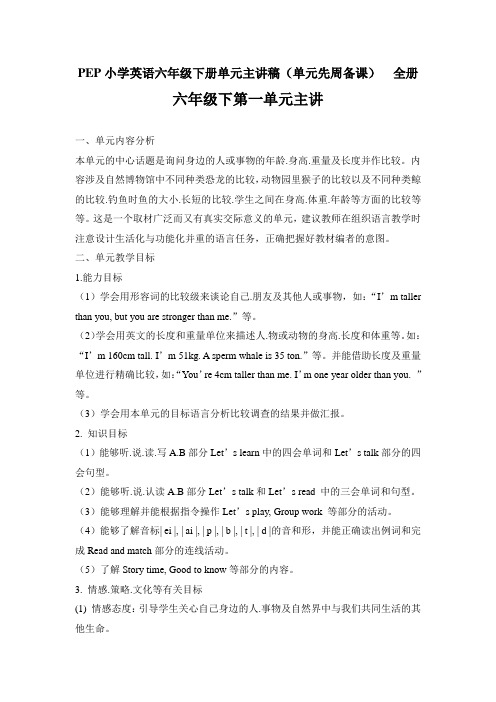
PEP小学英语六年级下册单元主讲稿(单元先周备课)全册六年级下第一单元主讲一、单元内容分析本单元的中心话题是询问身边的人或事物的年龄.身高.重量及长度并作比较。
内容涉及自然博物馆中不同种类恐龙的比较,动物园里猴子的比较以及不同种类鲸的比较.钓鱼时鱼的大小.长短的比较.学生之间在身高.体重.年龄等方面的比较等等。
这是一个取材广泛而又有真实交际意义的单元,建议教师在组织语言教学时注意设计生活化与功能化并重的语言任务,正确把握好教材编者的意图。
二、单元教学目标1.能力目标(1)学会用形容词的比较级来谈论自己.朋友及其他人或事物,如:“I’m taller than you, but you are stronger than me.”等。
(2)学会用英文的长度和重量单位来描述人.物或动物的身高.长度和体重等。
如:“I’m 160cm tall. I’m 51kg. A sperm whale is 35 ton.”等。
并能借助长度及重量单位进行精确比较,如:“You’re 4cm taller than me. I’m one year older than you. ”等。
(3)学会用本单元的目标语言分析比较调查的结果并做汇报。
2. 知识目标(1)能够听.说.读.写A.B部分Let’s learn中的四会单词和Let’s talk部分的四会句型。
(2)能够听.说.认读A.B部分Let’s talk和Let’s read 中的三会单词和句型。
(3)能够理解并能根据指令操作Let’s play, Group work 等部分的活动。
(4)能够了解音标| ei |, | ai |, | p |, | b |, | t |, | d |的音和形,并能正确读出例词和完成Read and match部分的连线活动。
(5)了解Story time, Good to know等部分的内容。
3. 情感.策略.文化等有关目标(1) 情感态度:引导学生关心自己身边的人.事物及自然界中与我们共同生活的其他生命。
- 1、下载文档前请自行甄别文档内容的完整性,平台不提供额外的编辑、内容补充、找答案等附加服务。
- 2、"仅部分预览"的文档,不可在线预览部分如存在完整性等问题,可反馈申请退款(可完整预览的文档不适用该条件!)。
- 3、如文档侵犯您的权益,请联系客服反馈,我们会尽快为您处理(人工客服工作时间:9:00-18:30)。
pep小学英语六年级试讲稿第一篇:pep小学英语六年级试讲稿Unit 2 WHAT’S THE MATTER, MIKE? Good morning, everyone.I’m No.X.I’m glad to have a chance to stand here.Today I will teach Unit 2 the first period from PEP primary English for students in Grade Six.Shall we start?Hello, boys and girls.I’m unhappy because I have a cold.[cough., sneeze] Can you sing an English song for me to cheer me up? Twinkle twinkle little star, how I wonder what you are Thank you.I’m better now.ok, let’s begin our lesson.Do you remember why I’m unhappy? Yes, because I have a cold.Can you guess the meaning of have a cold? Yes, it means 感冒.Ok, read after me.Now I feel sick.Maybe I have a fever.Do you know have a fever? Yeah, you are so clever, it means 发烧.ok, read after meDo you know other problems? Please turn to page 16 and look at the pictures.Say some problems you see.You can speak in Chinese.Have a headache 头疼have a toothache 牙痛 Have a sore throat 咽喉痛hurt疼 Ok, read after me.Can you? You did a good job, so we can play a game.“low voice and high voice” Wonderful, now let’s try to listen to others’ problems.Turn to page 17, listen and number.Ok, let’s check the answers.Can you talk the problems as them? Now let’s learn how to talk th e problems.A: How do you feel? B: I feel sick.A: what’s the matter? B: My throat is sore.My nose hurts.Boys and girls, read after me.Ok, now it’s your time to be doctor try to ask others’ problems.Time flies, and you did a good job in this class.Let’s revi ew what we have learned.New words and phrases: New conversation: Atlast.Homework is to recite the problems we learned.Can you? I believe in you.You are so clever.Ok, class is over.This is my teaching for unit 2.thank you for listening.第二篇:小学英语试讲稿先进教室,然后回答两个问题,老师会说开始你的试讲就可以开始了。
这是整个的试讲流程开场:Hello,everyone!(good afternoon,ladies and gentlemen!)I am xxx and I am very glad to have this opportunity to give my English lessons here!(It’s a great honor for me to give my lessons here!).Maybe i am not good enough ,it is an honor for me if you point out the shortcomings and make corrections.Next,please allow me to show my lessons for you!讲课:Hi ,my dear children!(Good afternoon,boys and girls!Hello,everyone!)It is nice to meet you again in the beautiful sunshine day.Now ,let’s began our class!Let us sing the song we have learnt before.(歌曲名字)wa~~ it is very beautiful.now We have some new friends here.Who are they?ok,have a look.Open your books, and turn to page 100, look, who are they? What’s the matter with them? 教师出示一支体温表,说:This is a thermometer.If I have a fever, it will tell me.Let’s see Mike.Mike doesn’t feel well.He has a fever.指着Let’s learn的图片的Mike,教学“have a fever”。
让学生看图片,教授单词和短语.the second boy was get hurt,when you get hurt ,you feel very painful,just like him!look at the girl,she was had a cold,when you have a cold,you couldn't sto 1p coughing.what is the matter with the boy ?he looks very painful!he was had a toothach.when we have a toothach,we feel so uncomfortble,do we?the last boy was had a headach,when you have a headach,your head feel painful,you want to have a sleep.look atthe girl,what's the matter with her?she has a sore throat.when you have a sore throat,your throat will feel uncomfortable you want drink more and more water.In daily life,We are very likely to get sick,so,it is useful to learn some knowledge about those words.Ok, now,listen to the tape carfully.follow the tape and look at the cards to read the following words and sentences.ok very good, now ,who can read those words? Any volunteer?OK,lili。
good ,set down please.anyone else? Ok.xiaoming.your pronunciation is correct.Set down.well,now,one ss reads one word , one by one.Do u understand? Ok.Let’s start it form this syudent.Oh,good job.Let’s play a game;there are five different cards about five different sicks in my hand.Next,all students will take part in five groups,one group will get one cards,look at the cards carefully,i will ask you some questions later.for example 2 group one get the card of Mike,i will ask you,what's the matter with M ike?you should answer: I’m sick.I have a fever.Ok,now,I will give u those cards.what's the matter with xxx.各组调换卡片继续该活动。
活动完以后,well down.The rest of the time belongs to you,you can choose one student as your partner,one ask and the other answer.In the process,try to understand it and learn it by your heart)ok,all students were done well,now,let's review the words and sentences we have learned befor......ok.today.ok,everyone has done an excellent job,i am very happy 布置作业(hey,boys and girls,time is so fast,our class is near to the end,but ,homework is impossible to avoid.After you bake to home , you must listen these words and sentences three times following the tape, u can read it to your parents,if you want, you can practice.....practice the words with your mother or father,ok?Now,class is over!goodbye~)结束:that’s all,my lesson is over.I am very grateful for your listening,thank you ,thank you very much!(鞠躬~)3第三篇:小学英语试讲稿小学英语试讲稿{Good Morning, dear judgers!I am No.6, I am glad that I can have a chance to stand here, and hope you can like my lesson.Now, please allow me to start my lesson!}Hello, Boys and Girls!How are you doing today? Yes, I am great.Thank you!I hope all of you can be happy in our English Class, and I hope you can enjoy the English trip!Ok, let’s sing a song which we have learned last week, little star, are you ready? Ok, ready go!Twinkle twinkle little star.How I wonder what you are.Up above the world so high, like a diamond in the sky.Oh, it is wonderful!You did a good job!Now let’s hav e a short st class, we learned a new topic, do you still remember? Yes, we talked about weather last class.So what is the weather like today? Who can answer my question? Any volunteer? Wow, Jack, please.Good, yes!It is sunny today, but a little cold.Because it is winter now, we should put on more clothes because it is so cold outside.Sit down, please, Jack.Ok, now please look at the blackboard.Today we will learn Unit 4 Where is my schoolbag?Please look at me, there is a big picture in my hands, can you guess what is this? Yes, it is a classroom, and it is a big nice classroom.What can you see from this picture? Ruler, yes, desk, good, football, wonderful, schoolbag, great, pencil box, fantastic!Keys, very good!Yes, we can see many things from this picture and we also can find that they are in the different places.How to say it in English? Now, let’s learn a newlesson.Firstly, please look at some word cards in my hands here are 3 word cards, they are on, in, under, so can you guess what is the meaning of it? I think you got it, right? Ok, cindy, on, linda, in, Angela, under.Very good!Now, let’s look at the classroom again.Please find the schoolbag, yes, it’s here.The first conversation is : Where is my schoolbag? It is on the desk.Listen to me carefully.(repeat).Then please find the keys ,yes, they are over there.The second conversation is: Where are my keys? They are under the chair.Here, please pay attention to the different usage of is and are.We have talked about them many times before, I believe that you know them very well, right?Next please choose one classmate as your partner and do a short conversation.One student asks, and the other one answer, do you understand? Ok, time is up.Who can come here and do the exercise.Good, lisa and david,you two please, come here!Great, give me five, give me five, sit down please.Now, Let’s listen to the tape and fill in the blank with on in or under.Listen to the tape carefully, when you finish, please hands up.Ok, stop here.All of you did a good job.I think it is very easy for you, isn’t it? Because you are very clever!How time flies, it is time to say goodbye.Today’s homework is make some sentences with ON, IN, UNDER, and if you can, please teach your parents or your friends about the usage of on, in, under.Ok, that is all for today, good bye, see you next time! 第四篇:Unit 3 小学英语六年级试讲稿Unit 3LAST WEEKEND Good morning, everyone.I’m No.X.I’m glad to have a chance to stand here.T oday I will teach Unit 3 the first period from PEP primary English for students in Grade Six.Shall we start?Hello, boys and girls, I’m happy to see you.Can you sing an English song for me? Ok, are you ready?Twinkle twinkle little star, how I wonder what you areWow, you did a good job.Do you want to know what I did during the weekend? I watched TV, I cleaned the room, I washed the clothes and I visited grandparents.I did so many things, do you know what are they? Watched TV 看电视cleaned the room 打扫房间Washed the clothes洗衣服visited grandparents 拜访爷爷奶奶And my brother played football last weekend.Played football 踢足球Ok, today we are going to learn some things we did last weekend.Look at the blackboard and read after me.Wow, you did a good job.Now please do as me.You can stand up.Can you? Now I will speak the phrases and you do the actions, ok? Good.Now change, I do the actions and you speak the phrases.Now I will pick two of you to come here to play the game.Wonderful now let’s try to listen and circle on page 29 Ok let’s check the answers.If you are right, please put up your hands.Wow, good.Ok, let’s learn how to talk what did last weekend.A: What did you do last weekend? B: I played football.How about you? A: I visited my grandparents.B: Did you help them clean their room? A: Yes, I did.Boys and girls, read after me.Ok, now it’s your time to try to ask.Time flies, and you did a good job in this class.Let’s review what we have learned.New words and phrases: New conversation: At last.Homework is to recite the phrases we learned.Can you? I believe in you.You are so clever.Ok, class is over.This is my teaching for unit 3.thank you for listening.第五篇:英语试讲稿微信NTCECN整理Unit 7 How much are these pants? Good morning, dear judges.I’m the No.4 candidate, applying for middle school English teacher.It’s my great honor to be interviewed here.xoday my topic is unit y, how much are these pantsz Now I’ll begin my class.Leading-in Good morning, boys and girls, it is a fine day, is it? Yes, and my friend will hold the wedding at this weekend, so I want to buy some clothes for the party, could you help me? Thank you!Look at the screen, this shop is on sale, on sale, do you know it? For example, the bag was 200 yuan last wee|, but now it’s only 100 yuan, the bag is on sale, clearz 2o, let’s have a loo|, what can we buyz Presentation 3|ay, loo| at the picture, what’s thisz 4o you |nowz {es, shoes, shoes, we will walk with shoes, shoes, shoes, shoes.How about this one? You, please, shirt? Good, pay attention to 6sh”, 6ʃ”, shirt, sit down, please.Read after me, shirt, shirt.And this onez It loo|s li|e the letter 6x”, x-shirt, very good, you wear a T-shirt, too, that’s beautiful.T-shirt, T-shirt, T-shirt.Next, wow, cool, what’s thisz Who |nowsz 2|irt, that’s right, s|irt, girls li|e it, yesz 2|irt, s|irt, and this one, you please, pants, clever} Follow me, pants, pants, pa nts.Near the pants, what’s itz 4on’t |nowz xhe boy is right, but in English, we say sweater, sweater, my favourite clothes is sweater, it’s soft.Well, last one, stoc|ingz 2toc|ing is long, but this is short, they’re called soc|s.2oc|s, socks.Boys, read the se words loudly, clearly!Great!Girls, it turns yo now, en, loudly next time.Okay, class, finish 1a, 2minutes, go!Finish it? Last row, no.2, T-shirt, yes, g, no.3, a, no.4, d, no.5, c, next, f, next, e, h, last one, i.Nice work!Our friends are in the shop, let’s listen what they are tal|ing.1b, listen carefully and circle the things you hear, ready?What things do you circle? Socks, en, T-shirt, shoes, anymore? Pants, 微信NTCECN整理skirt, good!So, how much is this T-shirt? Seven dollars, dollar, look, this is one dollar, American money, like yuan, 1 dollar is about 6.5 yuan, and how much is about money, understand? How much are these socks? The boy in T-shirt, yes, they’re two dollars.How much is this skirt? Okay, the girl in T-shirt.It is 5dollars.How much are these shoesz {ou, please.xhey’re 12 dollars, than| you, sit down, please.Practice & Consolidation Look at the three pictures, how much are these thing? I know it.Try to ask me using these sentences on blackboard, I will tell you plus or minus, clear? Are you ready? Okay, girls, the shorts are 100 yuan, plus, 300 yuan? Minus, 250, plus, 280, yes!Picture 2, well, boys, come on, yes, how much is this schoolbag? 125? Minus, 100 yuan? Minus, 88, yes!How clever you are!Picture 3, haha, apples,29 yuan? Minus, 25 yuan, minus again, 20 yuan? A little difficult,I will tell you, these apples are 18.y yuan, last one, cellphone, it’s 5000 yuanz No, minus, 4000 yuan? Minus, 3500 yuan? Minus, yes, the cellphone is 2000 yuan.Class, our classroom is a shop.There are so many things, books, pencil boxes, your clothes and so on.We all now are buyers and shoppers, try to communicate with each other to label the prices, which group can know most? Now, 10 minutes, begin!Time is up!One volunteer of each group tells us your prices, group 1, wow, 6 things, wonderful!Group 2, 5 things, chalks are five yuan.Group 3, 7 things, too.I think the bag is beautiful.Group 3, clap for themselves.Summary & Homework So, class, close your books, look at these cards, read them loudly, this one, socks, next, T-shirt, next, pants, next, shoes, last one, skirt.Great!How much is this English boo|z It’s 26.8 yuan.5ow much are these candiesz xhey’re 11 yuan, here you are.Have agood weekend, see you!xhat’s my demo class, than|s for your attention.微信NTCECN整理微信NTCECN整理Unit 2 What’s the Best Time to Visit USA? Boys and girls, before class, I want to show you a video.Now, let’s have a look.What can you see? Oh, the president Obama, wonderful, the White House.Now can you guess where it is? Very good, it’s USA.Have you ever been to USA? Today, we’re going to learn something about USA.Pre-reading First of all, let’s look at the title, what can you get from the title? Yes, Mary, you said it’s about what has happened in the USA.Is she right, let’s see.I will play the tape for you, and you can try to find the places mentioned in the listening material, which belongs to USA.Now, let’s listen to the tape.Our listening is over, who can tell me the places you heard.Right, there are New York, Washington D.C., L.A., and New England.You have done a good job in the first listening, and I believe you can get more later.While-reading Now, boys and girls, I need your help.I want to travel to these places, but I don’s know when’s the best time and what the weather will be like.So, I would like you to pay more attention to the time and weather in the second listening.And this time, we will work in groups.You are divided into three groups, these two lines are group1, these are group2, and the next is group3.group1 talk about New York and Washington D.C., group2 find information about New England and Los Angeles, and group 3 tell the situation of Alaska.Now, I’ll give you five minutes to prepare.Take your time, class.Ok, lily, what’s your opinion? I see, you find that it is better to go to N.Y.in May and the weather is not too hot.Good point, let’s see other students’ results.Thank you for your advice, but based on the time and weather of these places, I still cannot make sure what things I should take.Can youdo me a favor? Ok, please read the passage and you will have two minutes to prepare.Now, I want to show you some pictures connected with the things in the passage.You can tell me what you微信NTCECN整理have seen.Ready? Go!Class, what did you see? Yes, there are swimsuit, camera, umbrella, map and warm clothes.You have really good memory.Keep your good work, let’s think why should I take them? You can discuss with your partner.Ok, who wants to share your idea? Diana, you find that because people may want to swim, so we should take swimsuits.Quite right.Anything else? Yes, jack, it’s not too cold, but it may be good to take warm clothes.Class, what do you think of your classmates’ ideas? I see, all of you agree to them, yes, we should make good preparation before leaving for somewhere.Post-reading Boys and girls, I am now curious to know that if you travel to USA, what will you take.Think about it and try to make a dialogue with your partner, imagine one of you is a guider and the other to be a visitor.What’s more, to use the new structure with because, so and but.Class, three minutes has passed, what have you talked about, who want to be volunteers? You are so brave, let’s give applause to Ann and her partner Jim.Summary After your excellent performance, class, think carefully what have you got from this class? Well, yes, new words like umbrella, swimsuit.And new structure with the use of because, so.Marvelous, I see, you also realize the wonder of the world and come to be interested at the cultures of different countries, especially western countries.Homework Class, I guess that all of you are going to learn more about the countries around the world, so why not write a short passage in order to generallyintroduce one country as you like.Maybe you should firstly search for information on the internet and then discuss with your parents about the part you want to write, and in the next class, please show “your country” to us, ok? See you!微信NTCECN整理TranscriptStep1 Lead in(5’)Hello, boys and girls, nice to see you again.How are you ? You are fine.Just so so.I have a question for you: What would you do if you had a million dollars? Think for a while and then talk with your partner.What would you do, Jake? Great, a generous and loving boy you are.What about you, Mike? Aha, you’d like to buy a house in Beijing.I should say you have a economical mind.OK, now, we will start studying Lesson 4 What would you do? Step2 Presentation(20’)Look at 1b, I will play the record for you, please listen and number the pictures in the order you hear them.Let’s start.OK, who can tell me your answer.Aha, Lily,please.Do you agree with her? Great, she is right.Now, look at 1c and tell me what 1c is talking about? Are you familiar with it? Great, we have talk about it at the beginning.You know the word million? Well a million is 1,000,000.We often say a million dollars or millions of lion is just like hundred and thousand in use.Pay attention to the pronunciations of medical and research, medical research.OK,guys, now, based on the conversation and take reference to the listening material, you are asked to make conversations with your partner.I will play the record again, please try to take down the important message as it would be helpful in the later process.OK, now, please start your task.Stop, here, you guys really have a imaginary mind.Now, I will play Part2for you, you are asked to finish 2a and 2b.Let us start.Who can tell me the answer of 2a.OK, Luke, please.Do you agree with him? Great, he is right.What about 2b? Can you tell me the answer together? Good job.Now,let’s focus o n the grammar.What would you do if you had a million dollars? I’d give it to the charity.Then, look at the next sentence: If I were you, I’d wear a shirt and tie.How to ask? Anyone , who want to have a try? Great, Rose.Very good, Rose said “what would you wear if had been invited to give a presentation?” Good question.What about the last sentence: If I were you, I’d take a small presents.Nike, could you design a question for this answer? Good, sit down please.Nike said “what would you do if you are invited to a friend’s birthday party?” Now, look at 2c,could you help Larry to solve her worries? Discuss with your partner with the sentence we have just learned about the solutions.I will give you five minutes.OK, time is up.You have such a heated discussion, you must have got many solutions.Well, what I want to point out is that “what if”, what if has the same meaning as what would you do if···.Not hard to understand, right?Step3 Practice(7’)Boys and girls, now we have learned the main words and sentence patte rns of this part, how much have you got? Let’s do practice.First, finish 3a in three minutes.Time is up.Tell me the answer together.Great!Now, I have a competition game for 微信NTCECN整理you.I will put you into three groups.Each group we need two actors and one judge.The actors to act according to the situations in 3a and the judges to give grades for their performance, clear? OK, let us welcome group one.which group got the highest mark? Congratulations to the second group!Step 4 Consolidation(8’)Let’s come to another activity.You guys in team 1 and team 2 please write your problems you meet currently.You can write no more than three.Dot forget your name.I will give you three minutes.Now, please hand in your problems.OK, all the problems are here, now, each of the others are asked to choose a note from here.Then, you should find the master of the note and then give him suggestions, clear? OK, stop here.Please go back to seats.Do you enjoy it? Step 5 Summary(3’)OK, now, we have learned the main content of Part A.How much have you got? Can you make a summary? Yes, we have learned some new words: million,medical,research,tie,worry,what if.Anything else?Exactly.We also learn the sentence pattern of What would you do if···,If I were you, I’d···what is important is that we should learn to think from multiple perspectives.Step 5 Homework(2’)In the end, I have to say you have homework to do.Think about the problems you meet now and try to solve them.If you meet some difficulty, you can ask your parents, your teachers or classmates for help.微信NTCECN整理英语试讲稿各位评委老师,大家好!我是应聘初中英语的三号考生,今天我要试讲的八年级下册第五单元第一课时If you go to the party, you will have a great time!!(板书题目)。
